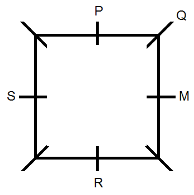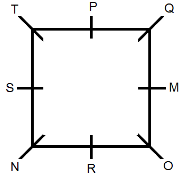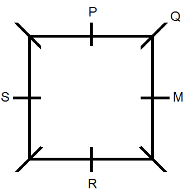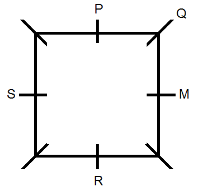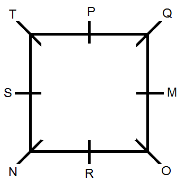CMAT Mock Test - 9 (New Pattern) - CAT MCQ
30 Questions MCQ Test - CMAT Mock Test - 9 (New Pattern)
Directions: Read the following information carefully and answer the question given below.
M, N, O, P, Q, R, S and T go for a party in a restaurant. They sit on a square table and face the centre in such a way that four of them sit in the middle of each of the four sides and rest sit at the corner of the table.
R sits second to the left of M. R sits in the middle of one of the sides of the table.
P sits second to the left of S, who does not sit at any of the corners of the table.
It is also known that only two people sit between P and N.
S is not an immediate neighbour of O.
N sits second to the right of T.
Q is not an immediate neighbour of S and is an immediate neighbour of P.
What is the position of R with respect to O?
R sits second to the left of M. R sits in the middle of one of the sides of the table.
P sits second to the left of S, who does not sit at any of the corners of the table.
It is also known that only two people sit between P and N.
S is not an immediate neighbour of O.
N sits second to the right of T.
Q is not an immediate neighbour of S and is an immediate neighbour of P.
Directions: Read the passage carefully and select the best answer to the question out of the given four alternatives.
The Berber, are a group of people indigenous to North Africa. In the Nalut district of the Tripolitania region, Ghadames, an oasis town is known as the "pearl of the desert". It is one of the oldest pre-Saharan cities and a grand example of a traditional settlement. Flying over, I was surprised to see just houses and more houses.
There didn't seem to be any pathways or alleys. Puzzled I flew down to investigate. I found that each house is built in such a way that it hangs over the alleys creating an underground network of passages. The ground floor of the house is used to store supplies, the next floor is for the use of the family and the open-air terraces are reserved for women. They were talking a language I did not understand. I later learnt it was Ghadams, a Berber language.
Towards the end of the month, for three days the old city of Ghadames comes alive with feasting, singing and dancing. It happens at the end of the date harvest.
When all the work is done, the people head to the city's World Heritage-listed old quarter to eat dates and celebrate. The people of the old quarter moved out in the mid-1980s, and live in the modern town. But, on this occasion they return to their family homes in the old city. They throw open the doors for singing, dancing and other festivities. The covered alleys provide shelter from the hot Sahara sun.
Q. Which part of the house is kept specially for the women folk?
Directions: Read the passage carefully and select the best answer to the question out of the given four alternatives.
The Berber, are a group of people indigenous to North Africa. In the Nalut district of the Tripolitania region, Ghadames, an oasis town is known as the "pearl of the desert". It is one of the oldest pre-Saharan cities and a grand example of a traditional settlement. Flying over, I was surprised to see just houses and more houses.
There didn't seem to be any pathways or alleys. Puzzled I flew down to investigate. I found that each house is built in such a way that it hangs over the alleys creating an underground network of passages. The ground floor of the house is used to store supplies, the next floor is for the use of the family and the open-air terraces are reserved for women. They were talking a language I did not understand. I later learnt it was Ghadams, a Berber language.
Towards the end of the month, for three days the old city of Ghadames comes alive with feasting, singing and dancing. It happens at the end of the date harvest.
When all the work is done, the people head to the city's World Heritage-listed old quarter to eat dates and celebrate. The people of the old quarter moved out in the mid-1980s, and live in the modern town. But, on this occasion they return to their family homes in the old city. They throw open the doors for singing, dancing and other festivities. The covered alleys provide shelter from the hot Sahara sun.
Q. While flying over, why won't we see any pathways in Ghadames?
Directions: Read the passage carefully and select the best answer to the question out of the given four alternatives.
The Berber, are a group of people indigenous to North Africa. In the Nalut district of the Tripolitania region, Ghadames, an oasis town is known as the "pearl of the desert". It is one of the oldest pre-Saharan cities and a grand example of a traditional settlement. Flying over, I was surprised to see just houses and more houses.
There didn't seem to be any pathways or alleys. Puzzled I flew down to investigate. I found that each house is built in such a way that it hangs over the alleys creating an underground network of passages. The ground floor of the house is used to store supplies, the next floor is for the use of the family and the open-air terraces are reserved for women. They were talking a language I did not understand. I later learnt it was Ghadams, a Berber language.
Towards the end of the month, for three days the old city of Ghadames comes alive with feasting, singing and dancing. It happens at the end of the date harvest.
When all the work is done, the people head to the city's World Heritage-listed old quarter to eat dates and celebrate. The people of the old quarter moved out in the mid-1980s, and live in the modern town. But, on this occasion they return to their family homes in the old city. They throw open the doors for singing, dancing and other festivities. The covered alleys provide shelter from the hot Sahara sun.
Q. 'The Berber' refers to:
Directions: The given item consists of an underlined word in the given sentence. The sentence is followed by four words. Select the word which is most similar in meaning to the underlined word and mark your response accordingly.
The navy gave tactical support to the marines.
Directions: In the following question, some part of the sentence may have errors. Find out which part of the sentence has an error and select the appropriate option. If the sentence is free from error, select 'No Error'.
Regional anaesthesia blocks transmission of nerve impulses (1)/ among a targeted part of the body (2)/ and the central nervous system. (3)/ No Error (4)
Directions: The given item consists of an underlined word in the given sentence. The sentence is followed by four words. Select the word which is most similar in meaning to the underlined word and mark your response accordingly.
The servants retired to their quarters.
Directions: Read the following passage carefully and answer the question. Certain words have been printed in bold to help you locate them while answering the question.
It is well recognised that domestic R&D (Research & Development) is an important ingredient in self-sustenance efforts of the country. However, efforts being made in this regard require to be further strengthened. National Level Policy changes are needed to encourage indigenous development of technologies with focus on few of the specific aspects discussed ahead.
R&D projects in India should be supported by the GOI (Government of India) but adequate authority should be given to the CPSUs (Central Public Sector Undertakings) and other government industries to decide their R&D partners which can be from Indian/foreign private or public sector organisations. To support commercialisation of indigenously developed products, an acceptable mechanism is needed for risk mitigation. This could be in the form of insurance scheme to cover any potential risk over and above the normal warranties and guarantees offered by the product developer and funded through the aegis of a R&D cess.
As per the Research & Development Act, 1986, as amended in 1995, a cess of 5% is being levied by the government on all payments made towards import of technology, etc. The government should encourage R&D in capital goods sector and other critical areas of strategic importance by providing funding from this cess. Further, additional R&D funds can be created by imposing a nominal cess on the turnover of every company, on the lines of the cess on petrol and diesel for developing national highways.
In certain specific areas identified for attracting FDI (Foreign Direct Investment), policy changes are necessary to include transfer of technology to an Indian company as a mandatory condition to allow access to our huge domestic market. Along with it, the GOI should work on mechanism to give special treatment to developing countries for transfer of clean coal technology on reasonable terms and conditions and in a manner that contributes to the long-term developmental prospects of the host developing country. This must be vigorously pursued.
Enunciate a clear policy to provide incentives for the commercialisation of products developed through indigenous R&D efforts. The incentive could be among others, in the form of exemption from excise duty at least for a period of five years from the date of commercialisation. Moreover, huge investments are needed in R&D, skill base development and new technologies to foster innovation. For example, latest research in the field of combustion process, gasification process, nanotechnology, high temperature steels, etc. finds application in a variety of sectors like energy, automotive, ship building, etc. Such inter-sectorial innovations can be effectively steered at government level for bringing out the synergy. Policy framework must support such research involving various sectors of industry with appropriate funding mechanism.
Q. According to the passage, which of following steps can help the country import new technology?
Directions: Read the given text carefully and fill in the blank with the most appropriate option that would complete the text.
The journalist was so vehement in his opposition to the controversial issue of black money in offshore accounts, that even when he moderated his comments, his piece was too ____________ for publication.
Directions: Mark the most suitable option to fill in the blank.
This may seem ___________, but if you put it into words, that is the only way to describe it.
Directions: Read the following passage carefully and answer the question. Certain words have been printed in bold to help you locate them while answering the question.
It is well recognised that domestic R&D (Research & Development) is an important ingredient in self-sustenance efforts of the country. However, efforts being made in this regard require to be further strengthened. National Level Policy changes are needed to encourage indigenous development of technologies with focus on few of the specific aspects discussed ahead.
R&D projects in India should be supported by the GOI (Government of India) but adequate authority should be given to the CPSUs (Central Public Sector Undertakings) and other government industries to decide their R&D partners which can be from Indian/foreign private or public sector organisations. To support commercialisation of indigenously developed products, an acceptable mechanism is needed for risk mitigation. This could be in the form of insurance scheme to cover any potential risk over and above the normal warranties and guarantees offered by the product developer and funded through the aegis of a R&D cess.
As per the Research & Development Act, 1986, as amended in 1995, a cess of 5% is being levied by the government on all payments made towards import of technology, etc. The government should encourage R&D in capital goods sector and other critical areas of strategic importance by providing funding from this cess. Further, additional R&D funds can be created by imposing a nominal cess on the turnover of every company, on the lines of the cess on petrol and diesel for developing national highways.
In certain specific areas identified for attracting FDI (Foreign Direct Investment), policy changes are necessary to include transfer of technology to an Indian company as a mandatory condition to allow access to our huge domestic market. Along with it, the GOI should work on mechanism to give special treatment to developing countries for transfer of clean coal technology on reasonable terms and conditions and in a manner that contributes to the long-term developmental prospects of the host developing country. This must be vigorously pursued.
Enunciate a clear policy to provide incentives for the commercialisation of products developed through indigenous R&D efforts. The incentive could be among others, in the form of exemption from excise duty at least for a period of five years from the date of commercialisation. Moreover, huge investments are needed in R&D, skill base development and new technologies to foster innovation. For example, latest research in the field of combustion process, gasification process, nanotechnology, high temperature steels, etc. finds application in a variety of sectors like energy, automotive, ship building, etc. Such inter-sectorial innovations can be effectively steered at government level for bringing out the synergy. Policy framework must support such research involving various sectors of industry with appropriate funding mechanism.
Q. Which of following is incorrect according to the passage?
Directions: Read the following passage carefully and answer the question. Certain words have been printed in bold to help you locate them while answering the question.
It is well recognised that domestic R&D (Research & Development) is an important ingredient in self-sustenance efforts of the country. However, efforts being made in this regard require to be further strengthened. National Level Policy changes are needed to encourage indigenous development of technologies with focus on few of the specific aspects discussed ahead.
R&D projects in India should be supported by the GOI (Government of India) but adequate authority should be given to the CPSUs (Central Public Sector Undertakings) and other government industries to decide their R&D partners which can be from Indian/foreign private or public sector organisations. To support commercialisation of indigenously developed products, an acceptable mechanism is needed for risk mitigation. This could be in the form of insurance scheme to cover any potential risk over and above the normal warranties and guarantees offered by the product developer and funded through the aegis of a R&D cess.
As per the Research & Development Act, 1986, as amended in 1995, a cess of 5% is being levied by the government on all payments made towards import of technology, etc. The government should encourage R&D in capital goods sector and other critical areas of strategic importance by providing funding from this cess. Further, additional R&D funds can be created by imposing a nominal cess on the turnover of every company, on the lines of the cess on petrol and diesel for developing national highways.
In certain specific areas identified for attracting FDI (Foreign Direct Investment), policy changes are necessary to include transfer of technology to an Indian company as a mandatory condition to allow access to our huge domestic market. Along with it, the GOI should work on mechanism to give special treatment to developing countries for transfer of clean coal technology on reasonable terms and conditions and in a manner that contributes to the long-term developmental prospects of the host developing country. This must be vigorously pursued.
Enunciate a clear policy to provide incentives for the commercialisation of products developed through indigenous R&D efforts. The incentive could be among others, in the form of exemption from excise duty at least for a period of five years from the date of commercialisation. Moreover, huge investments are needed in R&D, skill base development and new technologies to foster innovation. For example, latest research in the field of combustion process, gasification process, nanotechnology, high temperature steels, etc. finds application in a variety of sectors like energy, automotive, ship building, etc. Such inter-sectorial innovations can be effectively steered at government level for bringing out the synergy. Policy framework must support such research involving various sectors of industry with appropriate funding mechanism.
Q. Which of the following best introduces the above passage?
Directions: Read the following passage carefully and answer the question. Certain words have been printed in bold to help you locate them while answering the question.
It is well recognised that domestic R&D (Research & Development) is an important ingredient in self-sustenance efforts of the country. However, efforts being made in this regard require to be further strengthened. National Level Policy changes are needed to encourage indigenous development of technologies with focus on few of the specific aspects discussed ahead.
R&D projects in India should be supported by the GOI (Government of India) but adequate authority should be given to the CPSUs (Central Public Sector Undertakings) and other government industries to decide their R&D partners which can be from Indian/foreign private or public sector organisations. To support commercialisation of indigenously developed products, an acceptable mechanism is needed for risk mitigation. This could be in the form of insurance scheme to cover any potential risk over and above the normal warranties and guarantees offered by the product developer and funded through the aegis of a R&D cess.
As per the Research & Development Act, 1986, as amended in 1995, a cess of 5% is being levied by the government on all payments made towards import of technology, etc. The government should encourage R&D in capital goods sector and other critical areas of strategic importance by providing funding from this cess. Further, additional R&D funds can be created by imposing a nominal cess on the turnover of every company, on the lines of the cess on petrol and diesel for developing national highways.
In certain specific areas identified for attracting FDI (Foreign Direct Investment), policy changes are necessary to include transfer of technology to an Indian company as a mandatory condition to allow access to our huge domestic market. Along with it, the GOI should work on mechanism to give special treatment to developing countries for transfer of clean coal technology on reasonable terms and conditions and in a manner that contributes to the long-term developmental prospects of the host developing country. This must be vigorously pursued.
Enunciate a clear policy to provide incentives for the commercialisation of products developed through indigenous R&D efforts. The incentive could be among others, in the form of exemption from excise duty at least for a period of five years from the date of commercialisation. Moreover, huge investments are needed in R&D, skill base development and new technologies to foster innovation. For example, latest research in the field of combustion process, gasification process, nanotechnology, high temperature steels, etc. finds application in a variety of sectors like energy, automotive, ship building, etc. Such inter-sectorial innovations can be effectively steered at government level for bringing out the synergy. Policy framework must support such research involving various sectors of industry with appropriate funding mechanism.
Q. Which of following statements is correct in accordance with the passage?
Directions: Select the most appropriate meaning of the underlined idiom in the given sentence.
As the flood waters hit the coastal village, several families had a close shave.
Directions: In the following question, some part of the sentence may have an error of grammar or syntax. Find out which part of the sentence has the error and choose the correct option. If the sentence is free from errors, "No error" is the answer.
Two millions people (A)/ attended the meeting (B)/ held in parade grounds. (C)/ No error (D)
Which of the following idioms/phrases means 'like a spy'?
Directions: The sentence has two blanks, each blank indicating that something has been omitted. Choose the set of words for the blanks which best fits the meaning of the sentence as a whole.
Once there lived a cunning fox who always _____ to _____ others with its awful acts.
Directions: Select the most appropriate option to substitute the underlined segment in the given sentence. If there is no need to substitute it, select No substitution required.
A third of us are feeling compelled to check our phones in the middle of the night.
Directions: Select the option that expresses the central idea in the most clear, concise and correct manner.
Directions: The given item consists of an underlined word in the given sentence. The sentence is followed by four words. Select the word which is most nearly opposite in meaning to the underlined word.
Arrangements were made to handle the mammoth gathering tactfully
Directions: In the following question, choose the word which best fills the blank from the four options given.
Hardly would anyone ___________ that this straw could start a revolution.
Neelam, who is Deepak's daughter, says to Deepika, Your mother Rekha is the younger sister of my father, who is the third child of Ramlal. How is Ramlal related to Deepika?
Directions: Study the passage given below carefully and answer the following question.
In a family, P, Q, R, S, T and U are playing volleyball on a warm Sunday. P and T are brothers. U is the sister of T. R is the only son of P's maternal uncle. Q and S are the daughters of the brother of R's father.
Which of the following statements is correct?
Directions: Study the passage given below carefully and answer the following question.
In a family, P, Q, R, S, T and U are playing volleyball on a warm Sunday. P and T are brothers. U is the sister of T. R is the only son of P's maternal uncle. Q and S are the daughters of the brother of R's father.
How is R related to U?
Five persons - P, Q, X, Y and Z - are sitting in a park. P is the mother of X, who is the wife of Z. Y is the brother of P, and Q is the husband of P.
How is Q related to Z?
Five persons P, Q, X, Y and Z are sitting in a park. P is the mother of X, who is the wife of Z. Y is the brother of P and Q is the husband of P.
How is P related to Z?
Directions: Read the following information and answer the given question.
A group of eight members is comprised of two women - S and T, three men - U, V and W, and three children - X, Y and Z. Each of these eight must be in one and only one of the three teams being formed according to the following conditions:
(i) Each team must have either two or three members.
(ii) Each team must have at least one child.
(iii) S and X cannot be in the same team.
(iv) V and W cannot be in the same team.
(v) U and Y must be in the same team.
Which of the following pairs must be together in a team, if U is in the same team as V?
Directions: Read the following information and answer the given question.
A group of eight members is comprised of two women - S and T, three men - U, V and W, and three children - X, Y and Z. Each of these eight must be in one and only one of the three teams being formed according to the following conditions:
(i) Each team must have either two or three members.
(ii) Each team must have at least one child.
(iii) S and X cannot be in the same team.
(iv) V and W cannot be in the same team.
(v) U and Y must be in the same team.
Who must be in a team with only one other member, if the two women are in the same team?
Directions: Read the following information carefully and answer the question given below.
M, N, O, P, Q, R, S and T go for a party in a restaurant. They sit on a square table and face the centre in such a way that four of them sit in the middle of each of the four sides and rest sit at the corner of the table.
R sits second to the left of M. R sits in the middle of one of the sides of the table.
P sits second to the left of S, who does not sit at any of the corners of the table.
It is also known that only two people sit between P and N.
S is not an immediate neighbour of O.
N sits second to the right of T.
Q is not an immediate neighbour of S and is an immediate neighbour of P.
Four of the following five are alike in a certain way and hence, form a group. Find the one that does not belong to the group.
Directions: Read the following information carefully and answer the question given below.
M, N, O, P, Q, R, S and T go for a party in a restaurant. They sit on a square table and face the centre in such a way that four of them sit in the middle of each of the four sides and rest sit at the corner of the table.
R sits second to the left of M. R sits in the middle of one of the sides of the table.
P sits second to the left of S, who does not sit at any of the corners of the table.
It is also known that only two people sit between P and N.
S is not an immediate neighbour of O.
N sits second to the right of T.
Q is not an immediate neighbour of S and is an immediate neighbour of P.
How many people sit between M and T, when counted in clockwise direction from M?


